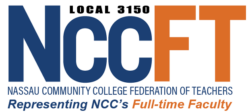Earlier this month, the NCCFT Executive Committee attended NYSUT’s Community College (ED39) conference in Latham, New York, where we received a briefing on Governor Cuomo’s much lauded Excelsior Scholarship program. While the program will likely benefit a significant number of students in New York State, we learned not only that “free tuition,” the term the state is using to promote the program, is misleading at best, but also that its requirements may in fact exclude many community college students from eligibility in the first place. What follows is a brief summary of what we learned, supplemented with information from the Higher Education Services Corporation’s Excelsior Scholarship FAQs.
Program Features
To start, the program is not an outright grant to pay a student’s entire tuition. Rather, it’s what is known as a “last dollar” award, meaning an eligible student will be receiving only enough money to cover any tuition costs remaining after her or his Pell, TAP, and/or scholarship funds are exhausted. To be eligible in 2017-2018, a student must come from a family with a federal household adjusted gross income of no more than $100,000. In addition, he or she must complete at least 12 credits per semester and 30 credits per year at a New York State public college, while maintaining a GPA necessary for completion of all coursework. Students who are currently attending a public college must meet the same income, credit, and GPA requirements, but they must also, according to the Higher Education Services Corporation, demonstrate that they are already “on track to complete their degree on time.”
This expectation, that eligible students will complete an Associate’s Degree in two years and a Bachelor’s Degree in four, is a hard line baked into the program. So, for example, students who have completed an associate’s degree will only be eligible for an award to pursue a bachelor’s degree if they enroll in a four year school immediately after they graduate from community college. If they take a break, they will no longer be eligible. Similarly, students who began college in the past and who want to come back to school are ineligible for the Excelsior because they are considered “not on-track to complete [their degree] on time.” (See HSEC’s Excelsior Scholarship FAQs.)
SUNY and CUNY students who qualify will be eligible for scholarships of up to $5,500 or actual tuition, whichever is less, but that money is not awarded directly to the student. Rather, the college an eligible student attends agrees, first, to freeze tuition rates for as long as that student qualifies up to a maximum of four years and, second, to defer that student’s tuition and be reimbursed by New York State once the college has certified that the student has met the credits-per-year and GPA requirements.
Some flexibility regarding the credit requirements is built into the program. Students can count towards their eligibility college credits earned while they were in high school, as well as credits earned under non-matriculated status; and while non-credit courses do not technically count towards full-time attendance for Excelsior purposes, students enrolled in non-credit classes can meet eligibility requirements if they are able to complete 30 credits in the year for which they applied. For students with disabilities covered under the American with Disabilities Act of 1990, the credit requirements are waived.
Students who receive Excelsior money must agree to a contractual obligation to live and work in New York State for a period of time equal to the number of years for which they received an award. If a student received an Excelsior Scholarship for one year, for example, he or she would have to live and work in New York State for a period of one year after they receive the award. Here, too, there is some flexibility built into the program to accommodate special circumstances, for example, military personnel or students who pursue further education outside of New York State.
Finally, if an Excelsior student fails to meet any of the program’s requirements, then his or her award will be converted into a 10-year no-interest loan that will be administered by the Higher Education Services Corporation (HSEC).
Some Observations
Clearly the program is targeted very specifically at traditional students, who go to college right after graduating high school and who graduate on time—or, to put it another way, students who, generally speaking, come from the middle class. Indeed, as The New York Times pointed out when the program was announced, Governor Cuomo “has always emphasized that [this is the population] his plan is designed to help.” The problem is that these students make up an increasingly smaller portion of the population. According to that same Times article, the Excelsior eligibility requirements will disqualify, by definition, “more than 90 percent of [community college] students and 60 percent of students at four year colleges. Given how often our students need to take time off from college, or drop from full to part time status, in order to work, those numbers are not hard to believe.
NYSUT estimates that approximately 30,000 to 35,000 students will be eligible to apply for the Excelsior Scholarship in 2017-2018. Since most four-year institutions have already admitted their incoming classes, we can expect that the majority of those eligible students will apply to community colleges. What that will mean for our student body and for the college budget—remember tuition for those students will be both frozen and deferred—only time will tell. Still, overall, the Excelsior Scholarship seems to be a step in the right direction. Hopefully, as the kinks get ironed out through implementation, the state will find ways to extend its benefits to even more students.
